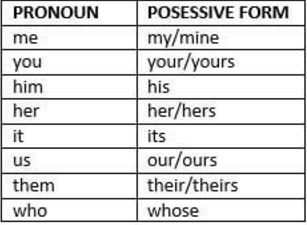This post originally appeared on the Magoosh TOEFL blog.
Today we will look at the way apostrophes are used with possessive pronouns… or rather how they aren’t used, in most cases. For the most common pronouns in the English language, you do not use an apostrophe to note possession. Instead, these common pronouns change other aspects of their spelling and word form when they become possessive.
Below is a chart of the eight most common pronouns in English and their possessive forms:
Notice that some of these pronouns have two possessive forms. That’s because, in the case of me, you, her, us, and them, the possessive form changes depending on its position in the sentence.
My/mine are irregular forms. But for the other pronouns, if the possessive pronoun is not followed by the word for the possessed object, it will have an s added to it. If the possessive pronoun is followed by the possessed object, it won’t have an s.
If this still sounds a little confusing, don’t worry—you’ll get the hang of this pattern quickly by looking at the examples below. (The possessed objects are underlined, and the possessive pronouns are in bold.)
- The two forms of possessive me
- That’s my dog.
- (Because the possessive form of me is followed by “dog,” the object being possessed, it’s written as “my”.)
- That dog is mine.
- (The possessed object “dog” does not appear after the possessive pronoun, so mine is used instead.)
- The two forms of possessive you
- Is this your car?
- (The possessive is followed by the thing that’s being possessed—the car. So it doesn’t have an s at the end.)
- Is this car yours?
- (In this similar sentence, the possessive pronoun appears after “car,”, so it ends in s.)
- The two forms of possessive her
- We can’t hold the party at my house; ask Jennifer if it’s OK to hold the party at herhouse
- (Her comes before the underlined possessed object.)
- We can’t hold the party at my house; ask Jennifer we can hold the party at hers (Hers is used, because no noun appears after the possessive… or even before the possessive in this case. The house that belongs to Jennifer is implied but not directly mentioned.)
- The two possessive forms of us
- There is our back yard.
- (Our is followed by the possessed noun.)
- That back yard is ours. (Ours appears at the end of the sentence and is not followed by the possessed noun.)
- The two possessive forms of them
- I don’t want to interrupt their meeting.
- (Their is used before a possessed noun.)
- I don’t want to interrupt a meeting of theirs.
- (Theirs is not followed by a possessed noun.)
Read the chart and examples above carefully, and you’ll be able to master these eight no-apostrophe possessive pronouns. Most other possessive pronouns do use apostrophes, so they’re thankfully much easier to use correctly. Here are just a few examples of the many pronouns whose possessive forms have an apostrophe and an s at the end, following the same apostrophe+s rule seen in this Magoosh post.
- Everything: Could you point to the tool you need? I don’t know everything’s name in this box of strange tools.
- Someone: This looks like someone’s leftover breakfast from this morning. Should I throw it away?
- Nobody: Nobody’s dream vacation is truly inexpensive.
Hablas español? Você fala português? Check out Magoosh’s TOEFL Spanish and Portuguese blog posts with top study tips and practice exercises written in Spanish and Portuguese.
This post was written by David Recine, TOEFL expert at Magoosh. For more TOEFL resources and practice tips, head over to the Magoosh TOEFL blog!

 ABA Journal The digital English academy
ABA Journal The digital English academy





